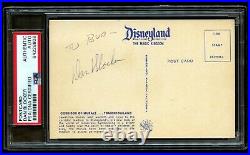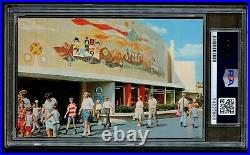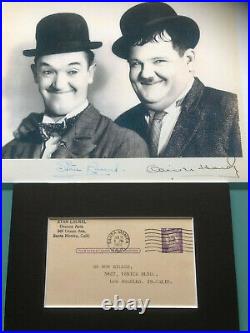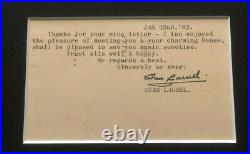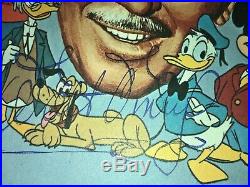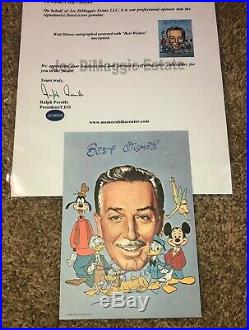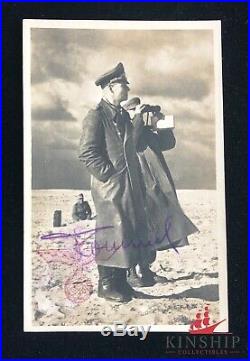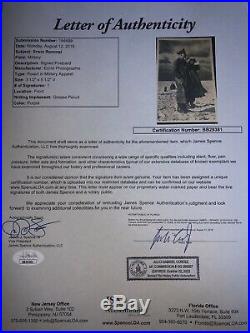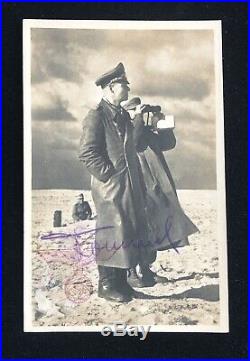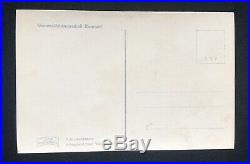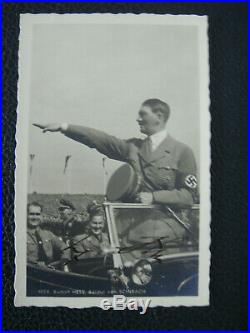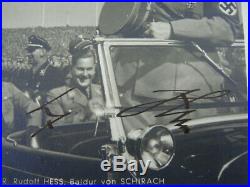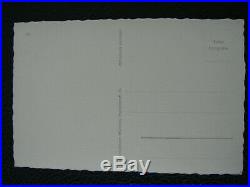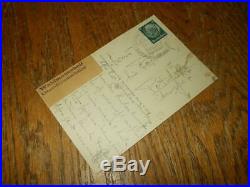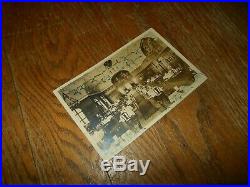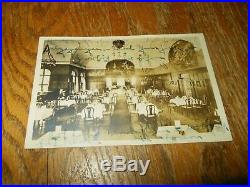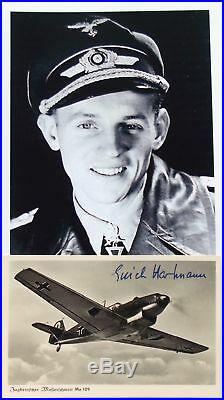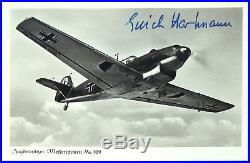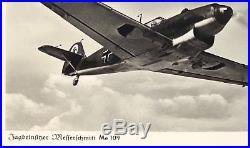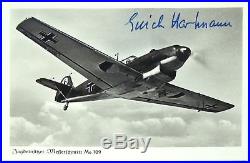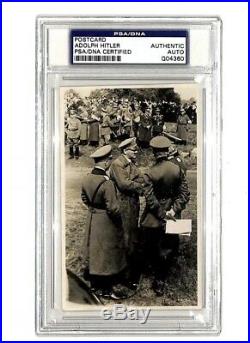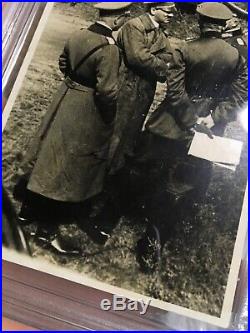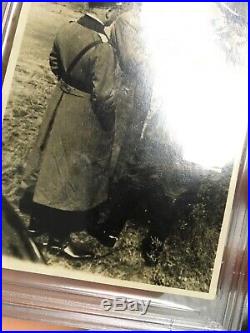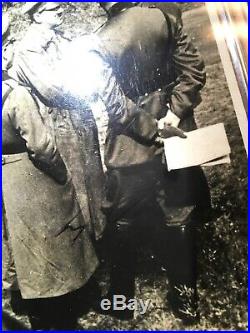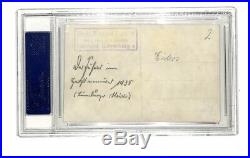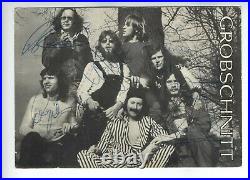
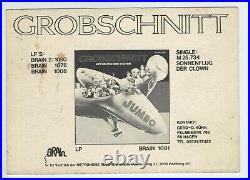

GROBSCHNITT VINTAGE ORIGINAL ADVERT CARD PHOTO SIGNED BY MEMBERS OF THIS LEGENDARY KRAUTROCK BAND. Grobschnitt was a West German rock band which existed between 1970 and 1989. Their style evolved as time passed, beginning with psychedelic rock in the early 1970s before transitioning into symphonic progressive rock, NDW and finally pop rock in the mid-1980s. [1] Their style evolved as time passed, beginning with psychedelic rock in the early 1970s before transitioning into symphonic progressive rock, NDW and finally pop rock in the mid-1980s. Grobschnitt, unlike other bands, utilized humor in their music in the form of unexpected noises and silly lyrics and concepts. As was common with many German bands of the time, Grobschnitt sang in English until the early 1980s, despite touring exclusively in West Germany. The band accrued a loyal fan base through its live performances which included pyrotechnics and German comedic sketches. Highlight performances include Solar Music, an extended mostly instrumental piece which lasted up to an hour. Grobschnitt were also known for their stamina on stage, frequently performing shows in excess of three hours. Grobschnitt formed in 1970 from the ashes of The Crew, a psychedelic rock band led by drummer Eroc (Joachim Ehrig). [1] Their new name meant “rough cut”, in reference to the style of tobacco. Originally an eight-piece band, Grobschnitt released their self-titled album on Brain Records in 1972[2] before paring down into their standard five-piece unit. Their first record is stylistically very different from the symphonic sound that became their hallmark. Ballermann, released in 1974, [2] featured new classically trained keyboardist Mist (Volker Kahrs). Released as a double-album, Ballermann featured humor and silly songs which followed from their entertaining live shows. The second record contains the first released version of “Solar Music”, an extended instrumental suite with origins in a piece by The Crew in the late 1960s. “Solar Music” would see frequent performances throughout the band’s career as well as being released in two more versions during the band’s existence. By 1975, Wolfgang “Popo” Jäger joined Grobschnitt as a bassist and the group released Jumbo. [2] Jumbo fully realized the symphonic style the band had developed, featuring lush keyboard usage. 1977 saw the release of Rockpommel’s Land after a German lyric release of Jumbo in 1976. [2] Rockpommel’s Land would prove to be Grobschnitt’s first commercial success, despite the waning appeal of progressive rock. Solar Music Live, released in 1978, [2] consists of a longer version of the “Solar Music” suite first revealed on Ballermann. Solar Music Live was a commercial success. By 1979 Grobschnitt moved towards shorter song-oriented releases. Merry-Go-Round would be Grobschnitt’s last release in the 1970s. Its songs made humorous digs at the disco music trend, commercialism and America. Grobschnitt released another live album, Volle Molle, in 1980, [2] documenting the recent Merry-Go-Round tour. Popo was soon replaced by Milla Kapolke, before recording the Illegal album in 1980. The subsequent Illegal tour was highly successful. Keyboardist Mist left Grobschnitt before the 1982 recording of Razzia, [2] a NDW-influenced album. Toni Moff Mollo, a friend of Eroc and long-time performer in live shows, was promoted to full member. Grobschnitt’s single from Razzia, “Wir wollen leben” (“We Want to Live”), remains a minor footnote in NDW history and proved to be the band’s last success. Eroc left Grobschnitt by June 1983, leaving Lupo as band leader. [2] In 1984 Grobschnitt released Kinder und Narren, sporting a distinctly 80s sound with the help of the DX7 synthesizer. Grobschnitt, having abandoned “Solar Music” for several years released a new live version in 1985, Sonnentanz: Live. Another rock-pop album named Fantasten followed in 1987. After Eroc’s departure members of Grobschnitt became more transient, many of whom came from the NDW band Extrabreit. Eventually, with the release of Last Party Live in 1989 Grobschnitt disbanded. Interest in Grobschnitt led to a partial band reunion from May 2007 with Wildschwein, Milla Kapolke and Toni Moff Mollo. Their repertoire consists of classic Grobschnitt songs throughout their career. Dubbed “Next Party”, they performed several concerts in 2007 and 2008. Hopes of a full reunion were dashed with the death of Wolfgang Jäger on May 3, 2007. [3] In 2008, Grobschnitt, after 17 years of “silence”, released their CD: Grobschnitt Live 2008. Former band member Mist (Volker Kahrs) died on July 20, 2008 at age 57. Circumstances were unknown or not released to the public. Lupo (Gerd Otto Kühn) – literally, “wolf” (in Italian). Mist (Volker Kahrs) – “manure” (in German). Willi Wildschwein (Stefan Danielak) – “Willi wild boar” (in German). Popo (Wolfgang Jäger) – “bum”, “bottom” (in German), though credited as “Pepe” on the “Jumbo” album. Toni Moff Mollo (Rainer Loskand). Jumbo (1975) (in English). Jumbo (mit deutschen Texten) (1976) (in German). Rockpommel’s Land (1977). Solar Music Live (1978). Kinder und Narren (1984). Last Party Live (1990). Grobschnitt Live 2008 (2008). All releases in West Germany / Germany, with the following additions. Rockpommel’s Land Canada, Bomb Records, 1978? Sonnenflug / Der Clown (1976) (“Sun Flight” / “The Clown”). Merry-Go-Round / Coke-Train (1978). Joker / Waldeslied (1980) (“Song of the Wood”). Silent Movie / Raintime (1981). Wir wollen leben / Wir wollen sterben (1982) (“We Want to Live” / “We Want to Die”). Wie der Wind / Geradeaus (1984) (“Like the Wind” / “Straight ahead”). Unser Himmel (1987) (“Our Heaven”). The International Story (2006). Die Grobschnitt Story 1 (1994). Die Grobschnitt Story 2 (1998). Die Grobschnitt Story 3: The History of Solar Music Vol. Die Grobschnitt Story 4: Illegal Tour 1981 Complete (2003). Die Grobschnitt Story 5 (2004). Die Grobschnitt Story 6: Rockpommel’s Land And Elsewhere… “Silver Mint Series” is a set of full concert recordings remastered and released by Eroc. Each multiple-CD concert is being released one CD at a time, three every six months until 2009. Confirmed concert releases are. Grobschnitt, die beste deutsche Liveband. 1966 wurde in Hagen eine Band mit dem Namen CREW gegründet. Diese Band kann zweifellos als Vorgänger von GROBSCHNITT bezeichnet werden, da sich hier erstmals einige der späteren Bandmitglieder formierten. Die CREW setzte sich aus folgenden Musikern zusammen. Stefan Danielak, Gerd Otto Kühn, Joachim H. Ehrig, Peter “Kasi” Klassen und H. Die CREW, die sich auch später CREW BLUES SESSION nannte, coverte Musik damaliger Rockgrößen wie zum Beispiel den CREAM, STEPPENWOLF, JIMI HENDRIX und weiteren angesagten Musikern/Gruppen der damaligen Zeit. 1968 waren sie bereits als wildeste, verrückteste und frechste Radaubrüder verschrien (siehe auch Texte zur LP “EROC 3″). Die Band absolvierte im Laufe ihres Bestehens mehr als 200 Liveauftritte. Auf dem Recklinghausener Beatfestival belegte die CREW BLUES SESSION 1969 von 90 teilnehmenden Gruppen den 5. Plattenveröffentlichungen hat es nach meiner Kenntnis nicht gegeben. Im Jahr 1968 nahm die CREW das Stück “Around Here” auf. Das Stück wurde dann später von EROC auf seinem Album “3” unter dem Titel “He’s Around Here” veröffentlicht. Weiterhin sind auf der CD Grobschnitt Story Vol. 2″ die beiden Stücke “Born To Be Wild” und “My Little Girl von der CREW enthalten. Im Jahr 1969 löste sich die CREW auf, aus ihr bildeten sich die beiden neuen Gruppen CHARING CROSS und WUTPICKEL. CHARING CROSS machten in der Besetzung Gerd Otto Kühn (Gitarre), Bernhard Uhlemann (Baß) und Axel Harlos (Schlagzeug) eine Art Hardrock, während Joachim H. Ehrig (Schlagzeug), Kasi Klassen, Carlos Bottich (Gitarre) und Michael Barth (Flöte) als WUTPICKEL Free-Jazz spielten. Ob Stefan Danielak ebenfalls in der Formation mitgespielt hat oder eine musikalische Pause einlegte, ist mir aufgrund widersprüchlicher Publikationen nicht bekannt. Es dauerte jedoch kein Jahr, bis sich die Musiker im Februar 1970 entschlossen, beide Formationen zu einer Band zu verbinden. Bei der Suche nach einem geeigneten Bandnamen kam ihnen ein Foto aus dem Jahr 1916 zugute, welches Toni Moff Mollo zu einem Übungsabend mitgebracht hatte. Auf diesem Bild war eine Militärkapelle namens “Kapelle Elias Grobschnitt” abgelichtet. Man entschloß sich fortan unter dem Namen GROBSCHNITT aufzutreten. Eine Legende war geboren!!! In der Urbesetzung von GROBSCHNITT spielten zwei Schlagzeuger (Ehrig und Harlos), was für die damalige Zeit schon recht ungewöhnlich war. Der Grund lag darin, daß man keinen Musiker der beiden Bands ausschließen wollte. Im Laufe der Jahre wechselte die Zusammensetzung der Band mehrfach, so daß sich entsprechend den Neigungen der unterschiedlichen Musiker wie auch durch die weitere Entwicklung der Rock- und Popmusik ihr musikalischer Stil wandelte. Allerdings sind auf all ihren Platten Stücke enthalten, die trotz aller Stilwechsel unverkennbare Elemente von GROBSCHNITT tragen. Die Musik von GROBSCHNITT mit anderen Gruppen zu vergleichen, oder sie anhand von Stilrichtungen zu klassifizieren, fällt schwer. Sie selbst haben mal gesagt, daß es sich bei ihrer Musik um Klassik-Rock handelt. Ihr größtes Plus waren allerdings die legendären Liveauftritte, an die meines Erachtens auch die “Großen” der Branche zum damaligen Zeitpunkt nicht heranreichten. Neben der Musik bot sich dem Zuschauer eine Mixtur aus Theatereinlage, Witz, pyrotechnischen Effekten und einer guten Lightshow. Die Dauer ihrer Konzerte hing zum größten Teil von der Resonanz des Publikums ab. Es war ein ständiges geben und nehmen zwischen Musikern und Konzertbesuchern. Ein Konzert konnte daher schon mal vier Stunden dauern. Über die ganzen Jahre war GROBSCHNITT immer die Band der Fans, da sie nicht nur in großen Hallen, wie die Dortmunder Westfalenhalle, auftraten, sondern hauptsächlich in kleinen und mittleren Schützen-, Festhallen sowie in Schulaulen ihre Konzerte absolvierten. Sie kamen förmlich zu ihren Fans, und das machte sie aus. Ein jeder der sie gesehen hat, weiß was er an ihnen hatte, und jedem, der sie leider nicht sehen konnte, muß ich sagen. Du hast ein Stück Rockgeschichte verpaßt! Mit einem fast fünfstündigem Konzert verabschiedete sich die Band in der Besetzung Gerd Otto Kühn, Stefan Danielak, Rainer Loskand, Rolf Möller, Jürgen Lindemann und Harald Eller von ihrer jahrelang treugebliebenen Fangemeinde. Auch die Bandmitglieder der vergangenen Epochen waren an diesem Abend auf der Bühne als Gäste präsent. Der Fan, der an diesem Abend den weitesten Heimweg hatte, soll aus Neuseeland gekommen sein. Als Trost für die Fans erscheinen seit 1994 die “Grobschnitt Story’s” auf CD und auch die alten Alben finden seit 1998 ihren Weg auf die Silberscheiben. Interessant an der Sache ist, daß auf diesen CD’s auch noch Bonustitel hinzugekommen sind. The school band UNIVERSALS is founded. Members are Eroc, Klassen, Schäfer and Ziegenfeuter. The band CREW is born. The band’s musicians are: Lupo, Eroc, Wildschwein, Klassen and Stein. THE CREW operates under the band name CREW BLUES SESSION. Hüber joins the band for Stein. The CREW BLUES SESSION dissolves. From it emerge the bands CHARING CROSS with Lupo, Baer and Harlos as well as WUTPICKEL with Eroc, Klassen, Bottich, Barth and Toni Moff Mollo (Loskand). Eroc (Joachim Ehrig), Lupo (Gerd Kühn), Baer (Gerhard Uhlemann), Felix (Axel Harlos), Mercury (Hermann Quetting) and Wildschwein (Stefan Danielak) found the band “Elias Grobschnitt”. The first LP under the name “Grobschnitt” is published. Felix Harlos (drums) and Mercury (bass) leave the band, Mist (Volker Kahrs) joins the band. The double album “Ballermann” comes out with the track “Solar Music”. Popo (Wolfgang Jäger) joins the band as bassist for Baer, ?? LP “Jumbo” is released (English). LP “Jumbo” comes out in German. Rockpommel’s Land is published; Grobschnitt performs live in around 100 cities. The live album “Solar Music Live” appears. The Rockpalast (WDR) shows an excerpt from the Dortmund concert; Grobschnitt is voted the most popular group of the year in the Pop Polls of the magazines “Musik-Express”, “Musik-Express” and “Spotlight”. LP “Merry-Go-Round” comes out, longtime roadie and lighting mixer Toni Moff Mollo (Rainer Loskand) takes on some vocal parts. In addition to the LP “Illegal”, the live album “Volle Molle” will be released this year, Milla Kapolke will join the band as bassist for Wolfgang Jäger. The single “Silent Movie” climbs into the charts. Mist (Volker Kahrs) leaves the band, the album “Razzia” comes out; the new key man is called Jürgen Cramer. The single “We want to live” becomes the anthem of the peace movement, Eroc leaves the band, Peter Jureit joins the group as drummer for him. The LP “Children and Fools” appears. Jürgen Cramer leaves the band. With the LP “Sonnentanz live” the people of Hagen deliver a new version of “Solar Music” (with German lyrics), Tarzan (Thomas Waßkönig) can be heard and seen on the keyboards. Tour of 75 cities. The last studio album comes out with “Fantasten”. Milla Kapolke leaves the band for good. The band will play between February 24th. In the cast Lupo, Willi Wildschwein, Toni Moff Mollo, Admiral Top Sahne (Rolf Möller), Sugar Zuckermann (Sugar Lindemann) and Harry Stulle Portier (Harald Eller) their farewell tour under the title “Last Party Tour”. The CD “Last Party Live” is the group’s last release. EROC releases the double CD Die Grobschnitt Story Vol. 1″ which contains previously unreleased live recordings (including the Solar Music version “Powerplay), remixes, session recordings and interview recordings. On May 18th Toni Moff Mollo performs with his band RAZZIA in Solingen; the concert contains numerous rough cut songs; some of the musicians appear in original costumes. The albums “Grobschnitt”, “Jumbo” (German and English), “Rockpommel’s Land”, “Solar Music Live” and “Merry-Go-Round” appear on Repertoire as remastered CDs with bonus pieces. The Grobschnitt Story Vol. 2 appears in November. On November 8th this homepage sees the light of the internet. At the end of 2001 the first part of the “History of Solar Music” (double CD) will be released. The CD contains two live and one studio version of “Solar Music” from 1974, 1978 and 1979. In March the second part of the “History Of Solar Music” will be released as a double CD with recordings from 1973, 1979, 1982 and one whose place and time are no longer known. Part three of the “History of Solar Music” will probably also appear as a double CD this year. Krautrock (also called kosmische Musik, German for “cosmic music”[9][10][11]) is a broad genre of experimental rock that developed in West Germany in the late 1960s and early 1970s[10] among artists who blended elements of psychedelic rock, electronic music, and avant-garde composition among other sources. [12] These artists moved away from the blues influences and song structure found in traditional Anglo-American rock music, [13] instead utilizing hypnotic rhythms, tape-music techniques, and early synthesizers. [14][12] Prominent groups associated with krautrock music included Can, Neu! Amon Düül II, Faust, Harmonia, Ash Ra Tempel, Agitation Free, Guru Guru, early Kraftwerk, Tangerine Dream and Cluster. The term was popularized by British music journalists, who adopted the term “Krautrock” as a humorous umbrella-label for the diverse German scene, [15] though many so-labeled artists disliked the term. [16] The movement was partly born out of the radical student movements of 1968, [17] as German youth rebelled against their country’s legacy in World War II and sought a popular music distinct from traditional German music and American pop. [10] The period contributed to the development of ambient music and techno, [8] and influenced subsequent genres such as post-punk, new-age music, and post-rock. See also: Experimental rock and Rock music in Germany. A German student protest from 1968. Krautrock is a broad label encompassing diverse sounds and artists that emerged in West Germany during the 1960s and early 1970s. [19] The music was partially inspired by broad cultural developments such as the revolutionary 1968 German student movement, [10][20] with many young people having both political and aesthetic concerns. [21] Youth rebelled against both dominant American influence and conservative German entertainment such as schlager music, [21] seeking to liberate themselves from Germany’s Nazi legacy in World War II and create a new popular culture. [15] Dieter Moebius, of the bands Cluster and Harmonia, noted that we were a lot of the times on the streets instead of studying. As young people we were not very proud to be German… We were all tired of listening to bad German music and imitations of American music. Something had to happen. “[21] The movement saw artists merge elements of varied genres such as psychedelic rock, avant-garde forms of electronic music, funk rhythm, jazz improvisation and “ethnic” music styles, [5] typically reflecting a “genuine sense of awe and wonder. We were trying to put aside everything we had heard in rock’n’ roll, the three-chord pattern, the lyrics. We had the urge of saying something completely different. Jean-Hervé Peron of Faust. Core influences on these German artists included avant-garde composers Karlheinz Stockhausen and Terry Riley, and bands such as the Mothers of Invention, the Velvet Underground, the Beatles, [22] and Pink Floyd. [10] A significant influence was the work of American minimalists such as Riley, Tony Conrad, and La Monte Young, as well as the late’60s albums of jazz musician Miles Davis. [23] Some artists drew on ideas from 20th century classical music and musique concrète, [21] particularly composer Stockhausen (with whom, for example, Irmin Schmidt and Holger Czukay of Can had previously studied), and from the new experimental directions that emerged in jazz during the 1960s and 1970s (mainly the free jazz pieces by Ornette Coleman or Albert Ayler). [18] The Quietus noted the influence of Jimi Hendrix and James Brown on krautrock musicians. [24] Moving away from the patterns of song structure and melody of much rock music in America and Britain, some in the movement were drawn to a more mechanical and electronic sound. Until around 1973, the word “Deutsch-Rock” (“German Rock”) was used to refer to the new groups from West Germany. [25] Various sources claim that “Krautrock” was originally a humorous term coined in the early 1970s either by British disc jockey John Peel[26] or by the UK music newspaper Melody Maker, in which experimental German bands found an early and enthusiastic following. [27] The first use of the term however, was found in a full page advertisement from Popo Music Management and Bacillus Records promoting German Rock in the UK, in April 1971. [28] The music emerging in Germany was first covered extensively in three concurrent issues of the UK music paper New Musical Express in the month of December, 1972, by journalist Ian MacDonald, who may have been the first to coin the term. [29] The term derives from the ethnic slur “kraut”. “Kraut” in German can refer to herbs, weeds, and drugs. [30] Other names thrown around by the British music press were “Teutonic rock” and “Götterdämmer rock”. [30] West Germany’s music press initially used “krautrock” as a pejorative, but the term lost its stigma after the music gained success in Britain. Its musicians tended to reject the name “krautrock”. [31][30] This was also the case for “kosmische Musik”. [30] Musicologist Julian Cope, in his book Krautrocksampler, says “Krautrock is a subjective British phenomenon”, based on the way the music was received in the UK rather than on the actual West German music scene out of which it grew. [32] For instance, while one of the main groups originally tagged as krautrock, Faust, recorded a seminal 12-minute track they titled “Krautrock”, they would later distance themselves from the term, saying: When the English people started talking about Krautrock, we thought they were just taking the piss… And when you hear the so-called’Krautrock renaissance’, it makes me think everything we did was for nothing. Krautrock has been described as a broad genre encompassing varied approaches, [10][19] though The Quietus noted that most music in the genre, diverse as it is, shares an interest in electronics, texture and repetition. Summarized the style as “avant-garde musical collages of electronic sounds, rock music, and psychedelia” which typically featured “improvisation and hypnotic, minimalistic rhythms”. [12] Los Angeles Magazine summarized the genre as “where American psychedelica meets icy Germanic detachment”. [33] Critic Simon Reynolds described the style as where the over-reaching ambition and untethered freakitude of late’60s acid rock is checked and galvanised by a proto-punk minimalism… Music of immense scale that miraculously avoided prog-rock’s bombastics. [5] AllMusic described it as expanding on the musical explorations associated with art rock and progressive rock, but diverging from American and British groups’ emphasis on jazz and classical elements in favor of “a droning, pulsating sound that owed more to the avant garde than to rock & roll”. [14] According to The Line of Best Fit, some typical characteristics include “steady 4/4 beats, hypnotic, droning rhythms, and shimmering keyboards”. [34] Artists used early synthesizers and experimented with tape music techniques. [14] Pitchfork stated that the genre “in its platonic ideal should be basically instrumental; it should seamlessly meld electronics and rock instruments; it should favor long, drawn-over structures over short dynamic shifts, and steady-state rhythms over syncopation”. [35] Los Angeles Magazine describes it as a hypnotic, piston-pumping genre… Where drummers pounded out tightly-wound beats, bassists thumped pulsing notes, and zoned out singers warbled over it all in an absurdist drone. [33] The Stranger called krautrock an “innovative reconstruction of rock and electronic music”. The “Motorik” beat is the 4/4 beat often used by drummers associated with krautrock, [37] characterised by a kick drum-heavy, pulsating groove, that created a forward-flowing feel. [37] The motorik beat was used by Can in the song “Mother Sky”, and by Neu! On their debut album, [38] later being adopted by other krautrock bands. It has been widely used in many different styles of music beyond krautrock. [39] According to XLR8R, the term krautrock is often used by critics to signify the mesmerizing motorik rhythms pioneered by Can and Neu! “, but contested that “they represent merely a tiny fraction of the music that emerged from Germany during Krautrock’s Golden Age. [15] Matt Bolton of The Guardian makes a similar point, arguing that Neu! Certainly have little in common with Can’s eclectic experimentalism, Amon Düül II’s improvisational space rock or Faust’s cut-and-paste sound collages. Early 1970s, West Germany. Kosmische musik (“cosmic music”) is a term which came into regular use before “krautrock” and was preferred by some German artists who disliked the English label;[16] today, it is often used synonymously with krautrock. [40] More specifically, it may describe 1970s German electronic music which uses synthesizers and incorporates themes related to space or otherworldliness;[40][41] it is also used as a German analogue to the English term “space rock”. [42] The style was often instrumental and characterized by “spacy”, ambient soundscapes. [41] Artists used synthesizers such as the EMS VCS 3 and Moog Modular, as well as sound processing effects and tape-based approaches. [40] They largely rejected rock music conventions, and instead drew on “serious” electronic compositions. The term “kosmische Musik” was coined either by Edgar Froese in the liner notes of Tangerine Dream’s 1971 album Alpha Centauri[41] or by record producer Rolf-Ulrich Kaiser as a marketing name for bands such as Ash Ra Tempel, Tangerine Dream, and Klaus Schulze. [30] The following year, Rolf-Ulrich Kaiser’s Ohr Records released the compilation Kosmische Musik (1972) featuring tracks by Tangerine Dream, Klaus Schulze, Ash Ra Tempel, and Popol Vuh. [40] Kaiser eventually began referring to the style as “cosmic rock” to signify that the music belonged in a rock idiom. [42] German producer Conny Plank was a central figure in the kosmische sound, emphasizing texture, effects processing, and tape-based editing techniques. [16] Plank oversaw kosmische recordings such as Kraftwerk’s Autobahn, Neu! 75, and Cluster’s Zuckerzeit. Several of these artists would later distance themselves from the term. [40] Other proposed names for the style at the time were “Berlin School” and “Dusseldorf School, ” though none remained definitive. [41] The style would later lead to the development of new-age music, with which it shared several characteristics. [41] It would also exert lasting influence on subsequent electronic music and avant-garde rock. This article may contain indiscriminate, excessive, or irrelevant examples. Please improve the article by adding more descriptive text and removing less pertinent examples. See Wikipedia’s guide to writing better articles for further suggestions. Krautrock has proved to be highly influential on a succession of other musical styles and developments. Early contemporary enthusiasts outside Germany included Hawkwind and in particular Dave Brock who supposedly penned the sleeve notes for the British edition of Neu! S first album[43] Faust’s budget release The Faust Tapes has been cited as a formative teenage influence by several musicians growing up in the early 1970s such as Julian Cope (who has always cited krautrock as an influence, and wrote the book Krautrocksampler on the subject). The genre also had a strong influence on David Bowie’s Station to Station (1976) and the experimentation it inspired led to his’Berlin Trilogy’. Krautrock was also highly influential on the late-’70s development of British new wave and post-punk, notably artists such as Siouxsie and the Banshees, Public Image Ltd. Cabaret Voltaire, The Fall, Gary Numan, Joy Division, Orchestral Manoeuvres in the Dark, Simple Minds and This Heat. Kraftwerk in particular had a lot of influence on American electronic dance music of the 1980s: electro, house, techno and especially Goa trance. Ash Ra Tempel was strongly influential on the later development of 70s ambient as well as post-rock. Romantic Warriors IV: Krautrock. Dance of the Lemmings 71, a. Angel Dust (72, Illegal Bootleg CD, poor sound quality). Carnival in Babylon (72). Utopia (73, as Utopia, re-released as ADII w/ extra tracks). Live In London (73). Vive La Trance (74). The Classic German Rock Scene: Amon Düül 2 (74, 2LP). Made In Germany (75, 2LP or 1LP versions). Rock in Deutschland Vol. 1 (81, Compilation from Phallus Dei through Vive la Trance). Milestones (89, 2CD, Compilation from Phallus Dei through Vive la Trance). BBC Live In Concert (92, recorded’73). Surrounded by the Bars (93, mostly Remix/Compilation). The Greatest Hits (94, Compilation from Hijack through Vortex). Nada Moonshine # (95). Kobe (Reconstructions) (96, recorded’69-’71). Eternal Flashback (96, recorded’69-’71). Live in Tokyo (96). One of the most influential German bands in the history of progressive music and maybe one of the most unclassifiable bands of all time. Mystifying, primal, shredding, groaning, cosmic, unearthly, complex – all at the same time. Try Yeti or Dance Of The Lemmings. Well, Amon Düül II started off in the early seventies with some noisy German-electro-industrial kind of music, but later graduated to prog rock. Hi Jack, and Made In Germany are two LP’s more representative of their prog rock phase. This classic german band began in the late 60’s as a commune, then split into two bands Amon Düül and Amon Düül II. They have a long history and went through many changes along the way. Their style in the early years was very spacy and free-form psychedelic, gradually becoming more progressive, then more accessible, then another split occurred and there was Amon Düül UK. Their best output is from the early to mid 70’s period, and includes the albums Yeti, Dance of the Lemmings, Wolf City, Vive La Trance, Hijack and Made In Germany. After that they sort of went downhill. The albums before 1970 are more like free-form psychedelic nonsense, Carnival in Babylon is a real stinker. Wolf City is a good place to start, it’s probably their most progressive album yet still has a lot of the good psychedelic spirit carried over from Yeti and Lemmings. There’s also a great live album in there somewhere. Amon Düül II is one of the classic German bands. I have four albums, which tend to fall into two groups. The first two represent a very free-form, experimental/drug-influenced era for the band. They are Yeti and Tanz der Lemmings and they are fantastic. There is a great deal of variety across each of these double albums, particularly the latter. There is acid-drenched guitar ala Ash Ra Tempel, heavy guitar riffs ala Hawkwind, loads of ethnic percussion, and dreamy experimentalism. It all sifts together to make a psychedelic exploration that carries you to far away places. You don’t even realize you’ve been drifting along until you’re set back on the ground. It’s similar in vein to Popol Vuh, which is no wonder as they have shared members. A must hear for space fans. The other two albums come a few more years down the road. They are Vive le Trance and Made in Germany. The band takes a more song-oriented approach, though they aren’t commercial in any way. With these albums there is definite rhythmic structure in the songs instead of the 18+ minute free-form excursions found on the earlier albums. There is still plenty of heavy guitar soloing typical of the German underground as well several dreamy or breezy sections to wrap your brain around. Both male and female vocals (with fairly thick German accents on the English vocals) are more prevalent, as well. Made in Germany is an attempt at a rock opera. Overall, it’s similar to Vive Le Trance though I’d rate it a notch below simply because of the few duff tracks. There are some rockin’ tracks as well. Both are very good albums and worth an audition to see if they are suitable for your tastes. If you like lysergic experimentalism, start with Yeti and work your way forward. Phallus Dei may also be worth your while though reportedly not as good. If you prefer a little bit of structure to your music, start at Made in Germany or Vive Le Trance and work your way backward. Wolf City and Carnival in Babylon were released between the above four albums are said to be a cross between the two styles, as you might expect. They are generally highly regarded among Amon Düül II fans. Surrounded by the Bars contains remixed versions of the band’s better songs from their classic early seventies period but have never appeared together on a compilation before. Furthermore, the original band members have reformed – temporarily at least – to record two brand new tracks (not three, like the insert says) for the occasion. Let’s hope the reunion lasts, because the new tracks are quite good, although very unlike what the band had done before: “Surrounded By The Bars” is a modern take-off on one of their early tunes from Wolf City, sounding very techno-influenced and hard edged, with Renate’s voice sounding better than ever. “Dance on Fire” is a harder rocking tune, a bit noisy, with unusual vocal interplay – yet it has all the earmarks of strangeness that made their early work so good. The remixed tunes include “Kanaan, ” “Archangel Thunderbird, ” “Wolf City” and “A Short Stop at the Transylvanian Brain Surgery” from the second side of Dance of the Lemmings. The remixes sound considerably cleaner than the original versions, with some real stereo separation and depth. Since this is the only CD compilation of early material available by AD2, this would be a very good place for the novice to get their feet wet – their unique and unusual music has to be experienced to be understiood – and this contains some of the best examples from the 69-74 period. I could write novels about them, but I’ll try to restrain myself. Led by singer/guitarist/violinist/sax player Chris Karrer, whose totally bizarre vocal style is quite indescribable, full of manic yodels and wild animal sounds. Other longtime members: lead guitarist John Weinzierl whose fiery playing is unequalled, female vocalist Renate Knaup whose vocal range is quite incredible, and keyboardist Falk Rogner who posesses a very original organ/synth style. The first album is quite strange, imagine Pink Floyd at their weirdest and it still isn’t even remotely like this. The 20-minute title suite on Phallus Dei is one of the most incredible pieces of improvised music I’ve ever heard. Yeti is still weird, though they obviously are trying to be more accessible. The improvised side long title track isn’t as good as “Phallus Dei, ” yet is much more cohesive than most such space-rock. Dance Of The Lemmings is an incredible double album. “Syntelman’s March Of The Roaring 70’s” is a four-part, 15-minute suite, which is the closest thing to “conventional” prog they’ve done so far, with lots of Mellotron. The B-side, collectively entitled “Restless-skylinght-transistor-child”, is some of the most varied and eccentric music they did so far. “A Short Stop At The Transsylvanian Brain-Surgery” is the best track. Side C is “The Marilyn-Monroe-Memorial- Church, ” one of the most diffuse and incoherent side-long improvs I’ve ever heard. The rest of the album consists of spacy instrumetnals with prominent hard-rock guitar. With this album begins their “classic” period, Carnival In Babylon, Wolf City and Vive La Trance. You can’t go wrong with any of these. Vive La Trance becomes slightly more song-orientated, a tendency which was to continue for subsequent albums. The live album which followed drew exclusively from Yeti and Dance of the Lemmings. Many of the tracks are ruthlessly edited, which makes it a big disappointment, a double live LP would have served them better. Hijack was the first turning point for the band. They were trying to gain a wider audience without compromising their sound. It’s more conventionally progressive overall than previous albums, but the dark, murky tone that pervades the whole album immediately sets it apart. High point is the weird, percussive instrumental “Da Guadeloop, ” which most closely resembles Can. Made In Germany was originally released as a double LP, but was trimmed to a single for British and US release. I haven’t heard the full-length version, nor do I know anyone who has. Made in Germany is the closest they’ve got to mainstream commercial yet, but is still very listenable and progressive; the bottom hasn’t yet fallen out. Pyragony X followed a drastic lineup shift, thus the sound changed, and not for the better. There are traces of the great band they once used to be, but the LP is dominated by new members Stefan Zauner and Klaus Ebert, whose styles are too commercial and poppy to fit in to the style well. It wasn’t really a bad album, but is very difficult to enthuse oneself over. Almost Alive is supposed to be slightly better, but Only Human is the inevitable commercial sell-out fans have been dreading. Pop, straight rock, and even disco are exploited here, with no success at all. Not surprisingly, the band broke up afterwards. Vortex is a reunion of Karrer, Knaup and drummer Danny Fichelscher, and one in which all parties involved can actually be proud of what they accomplished. Carrying on in the style of Vive La Trance, it’s as though the band had never broke up. A must for fans. This item is in the category “Collectibles\Autographs\Music”. The seller is “memorabilia111″ and is located in this country: US. This item can be shipped to United States, Canada, United Kingdom, Denmark, Romania, Slovakia, Bulgaria, Czech Republic, Finland, Hungary, Latvia, Lithuania, Malta, Estonia, Australia, Greece, Portugal, Cyprus, Slovenia, Japan, China, Sweden, Korea, South, Indonesia, Taiwan, South Africa, Belgium, France, Hong Kong, Ireland, Netherlands, Poland, Spain, Italy, Germany, Austria, Bahamas, Israel, Mexico, New Zealand, Philippines, Singapore, Switzerland, Norway, Saudi Arabia, United Arab Emirates, Qatar, Kuwait, Bahrain, Croatia, Republic of, Malaysia, Chile, Colombia, Costa Rica, Panama, Trinidad and Tobago, Guatemala, Honduras, Jamaica, Antigua and Barbuda, Aruba, Belize, Dominica, Grenada, Saint Kitts-Nevis, Saint Lucia, Montserrat, Turks and Caicos Islands, Barbados, Bangladesh, Bermuda, Brunei Darussalam, Bolivia, Egypt, French Guiana, Guernsey, Gibraltar, Guadeloupe, Iceland, Jersey, Jordan, Cambodia, Cayman Islands, Liechtenstein, Sri Lanka, Luxembourg, Monaco, Macau, Martinique, Maldives, Nicaragua, Oman, Pakistan, Paraguay, Reunion, Uruguay.



